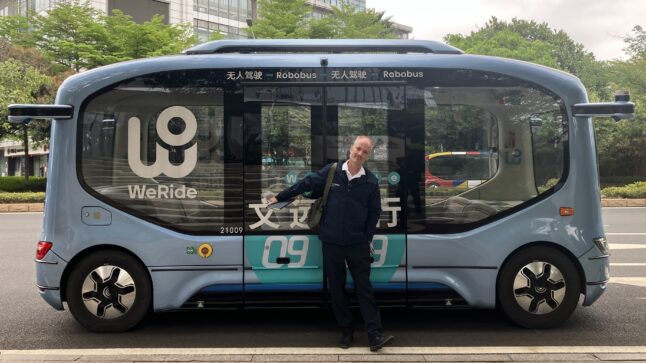I recently visited autonomous driving pioneer WeRide in Guangzhou. And visiting autonomous driving (AD) companies is particularly fun. You get to take rides in their vehicles.
Plus, I got to go to Guangzhou, which is a strange but fun city.
Guangzhou is the first-tier city that China kind of forgot. It has always lagged behind the other first tier cities. But it’s nice. With some modern buildings. And lots of greenery.
But it’s nothing like the development of Beijing, Shanghai and Shenzhen over the past twenty years. And even now, people talk more about newcomer Hangzhou than Guangzhou.
For me, the most interesting part of Guangzhou is its role in the Greater Bay Area. This is the sweeping initiative to connect and integrate Hong Kong, Shenzhen, Dongguan, Guangzhou, Foshan, Zhongshan, Zhuhai and Macao. Basically, turning all the cities around the bay into one economic entity. Which means building tons of bridges, rail lines and highways.
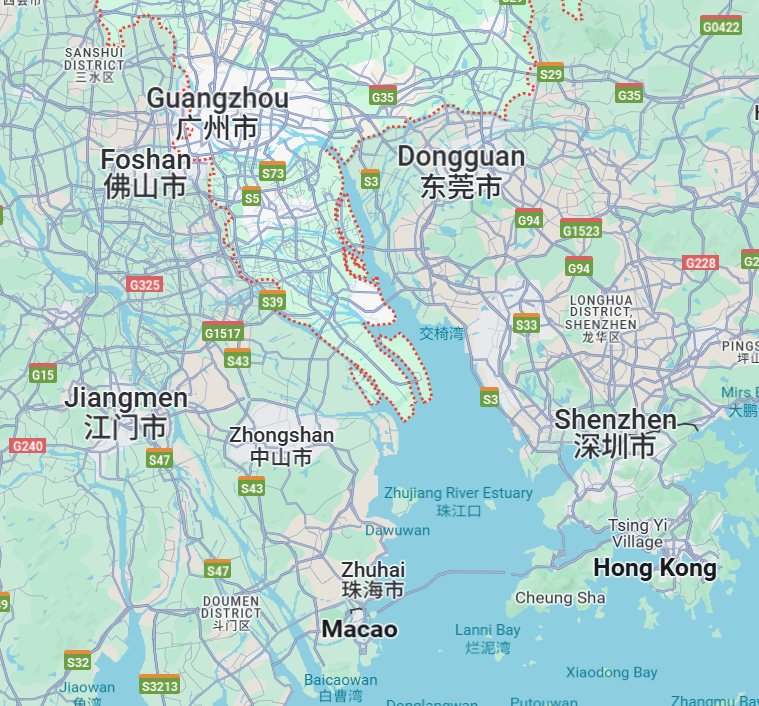
And the Greater Bay Area should be the world’s largest port.
The Port of Shanghai is currently the world’s largest port, with 50M TEU (twenty-foot equivalents) of shipments annual. But Shenzhen is 27M TEU and Guangzhou is 25M TEU, so when combined the Greater Bay Area is the largest. For comparison, Los Angeles is 10M TEU and Rotterdam is 13-15M TEU.
Note: A TEU is basically a container of cargo, which is different than bulk tonnage. Asia tends to be larger in TEUs (the factory of the world).
Anyways, that’s what I notice most when I’m in Guangzhou. It’s just a mass of infrastructure. Endless highways, tons trucks, and huge numbers of container ships coming and going.
The WeRide headquarters is in the middle of Guangzhou. It’s actually on an island in the middle of the river. It’s called the Guangzhou International Bio Island. And it’s full of biotech and other science-related companies. It’s a nice place. And you can ride WeRide’s autonomous vehicles around the island. The famous Guangzhou tower is also nearby.
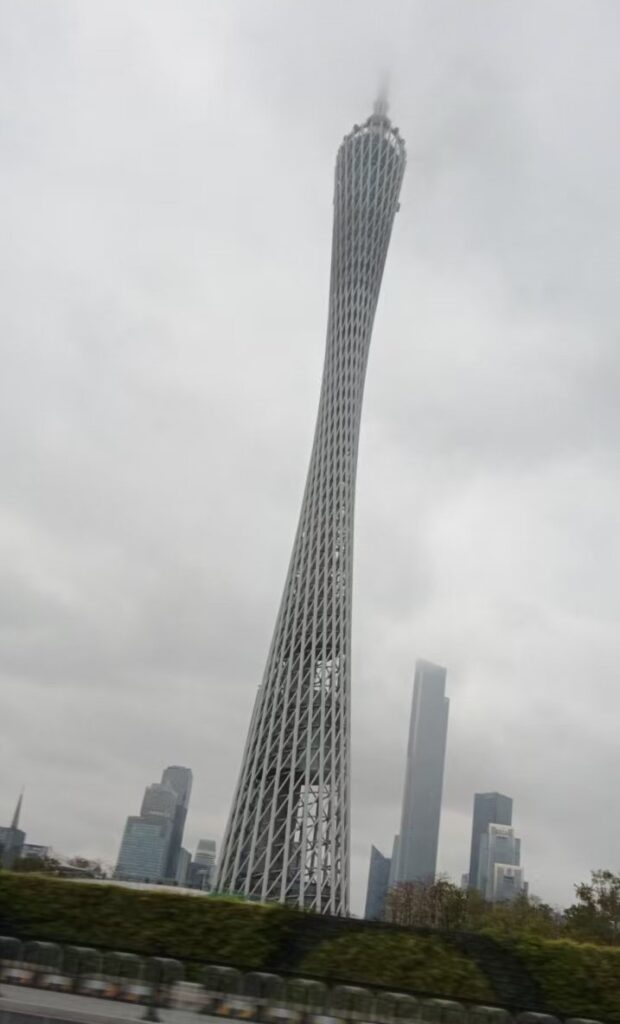
Let me go through the basics of WeRide a bit.
Understanding WeRide: Mission, Technology, and Vehicle Fleet
WeRide is a public company with multiple autonomous vehicles. It has been in the technology R&D, product development and small-scale commercialization phase. And is now focused on mass commercialization and going to market.
So, this article is mostly about its products and its business model. If you want to see the financials, you can look at the public filings. They show tons of spending on R&D and negative operating margin, which is not unusual for a company at this stage. This is a common feature of most companies in the AD industry.
WeRide was founded in 2017 with the mission creating vehicles with L4 Autonomous Driving. And that’s pretty daring. They didn’t start with assisted driving, like most. Not partial autonomy. They have been going for full autonomous driving from day one. That’s raises and interesting strategy question.
- Should you progress incrementally from L2 to L3 to L4?
- Or should you try to leapfrog to L4 from the start?
WeRide has been going for L4. And its approach has been to create the intelligence required for L4 and deploy it in multiple types of vehicles. They’ve already deployed robotaxis, robobuses, robovans, and robosweepers.
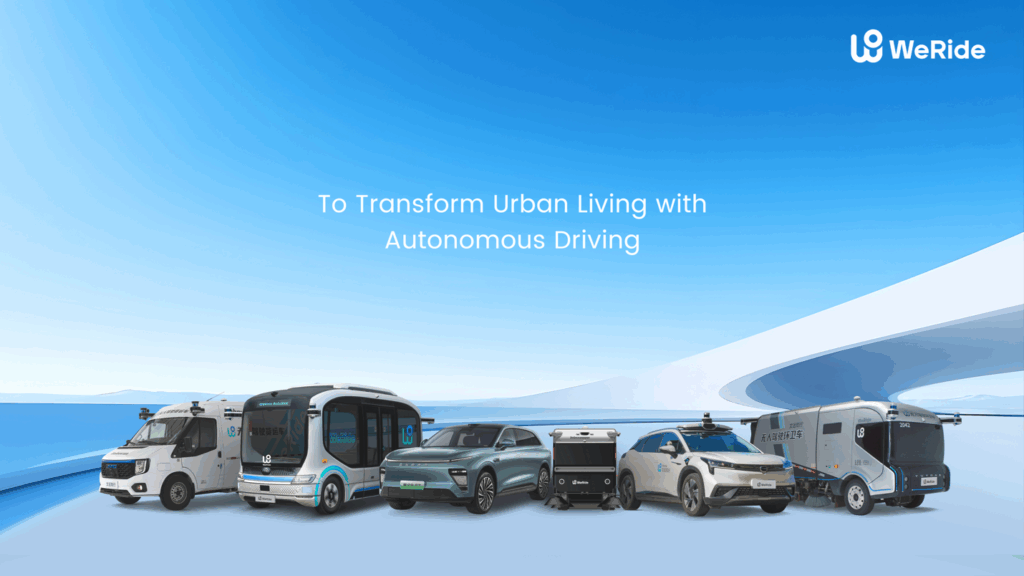
Within this, robotaxis are arguably the most compelling and the most difficult.
In theory, robotaxis will one day blanket the roads and replace many, if not most, automobiles. The TAM is huge.
But robotaxis are also a difficult use case for AD. They operate in dense urban environments, with lots of people, traffic and unusual use cases. They can encounter literally anything and must be ready for all the long-tail use cases. They also carry passengers and go at relatively high speeds. And of course, robotaxis require lots of regulatory approvals, as commercial vehicles that carry passengers.
That said, Tesla, Waymo, WeRide, Baidu, and others are all deploying robotaxis right now. It’s the space to watch.
I actually like the Robobus more.
They are easier. Buses run the same routes every day. You don’t need to understand every potential route and road. They also go slower (usually) and often have their own designated lanes. They stick to routes like airport trips, industrial parks tracks and specific neighborhood loops. WeRide currently has robobuses in 30 cities, such as Singapore, Beijing, Guangzhou, and Zurich.
It is interesting to see how attractive robobuses are to European countries, with their aging populations, limited number of drivers (expensive) and desire to reduce the cars on the roads (and carbon emissions).
WeRide also has Robosweepers.
Like buses, these sweepers run the same routes every day. And they’re not carrying passengers so regulations are easier.
But perception is a bigger challenge with robosweepers. They have to be close enough to the curb to get all the trash. But not too close. It requires much more precise driving.
Finally, there are Robovans.
In theory, these are useful for logistics and delivery companies. We have seen JD and Cainiao prototyping such vehicles for years. They are all over their business parks. They’re also not carrying passengers and are pretty close to delivery karts.
***
WeRide started to develop its ADAS (Advanced Driving Assisting System) solution in 2022, through a strategic partnership with Bosch. Their first use case was ready in 18 months, where their ADAS solution was utilized by Chery’s high-end EV brand Exeed.
Those are the core products. And WeRide’s approach is to have all these different vehicles running off a common universal AI / intelligent driving system. Together, they will capture lots of diversified use cases, making all the vehicles more intelligent. They call this centralized intelligence system WeRide One. From the annual report:
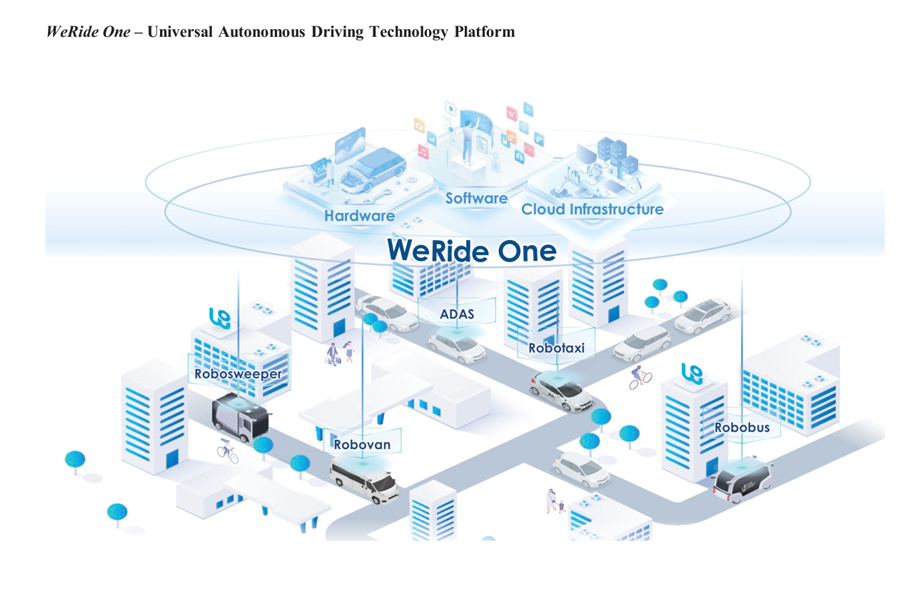
If lots of vehicle types are deployed in an urban environment, there should be a flywheel between the number of types of vehicles and the intelligence of the system.
Another interesting part of WeRide’s business model is the focus on highly modularized and standardized hardware. The L4 vehicles are all using the same basic hardware components. Perhaps as high as 90%?
This standardization of the hardware enables faster development of new vehicle types. Both at WeRide and with its OEM partners. Long-term, most vehicles will be made by OEM partners. Keep in mind, the key to L4 AD includes making mass production economically viable.
Take a look at the development path for WeRide. Note their mentions of the start of commercial production.
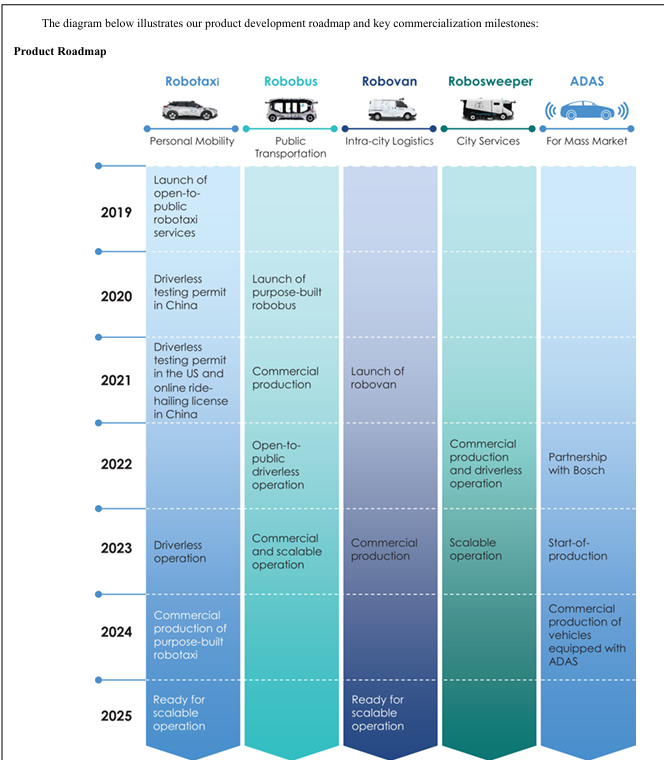
Ok. Let me go into my take-aways from the visit.
Take-Away 1: The Robobus Is Great. And a Glimpse into the Future of Mobility.
The name robobus is really not accurate. It feels nothing like a bus.
Inside, it’s like sitting in a living room. Or a conference room. It doesn’t feel much like a vehicle. And definitely not a bus.
I once heard someone explain AVs as the room of your house that can detach and move around. That’s what came to mind when I got on the robobus and it started going down the street.
Outside it’s pretty cool. Note the big sensors on the edges.
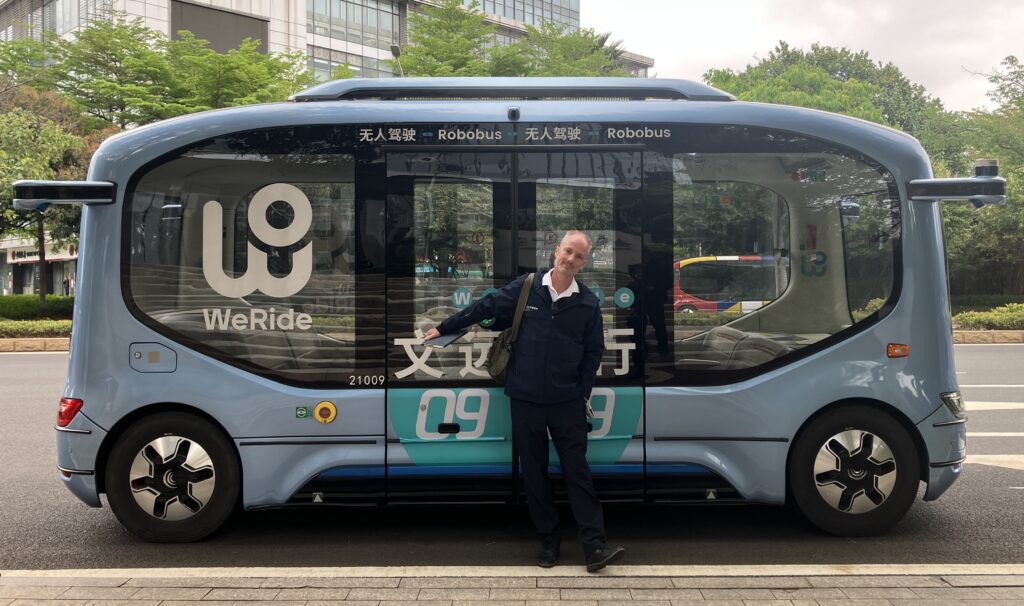
Inside it’s spacious. And the chairs all face to the center. Apparently I sat in the same seat that former Chinese Premier Li Keqiang sat in. Although maybe it wasn’t the same vehicle (who knows?). But it was a fun vehicle to chat in as it went around the island. It felt more like a conference room than a bus.
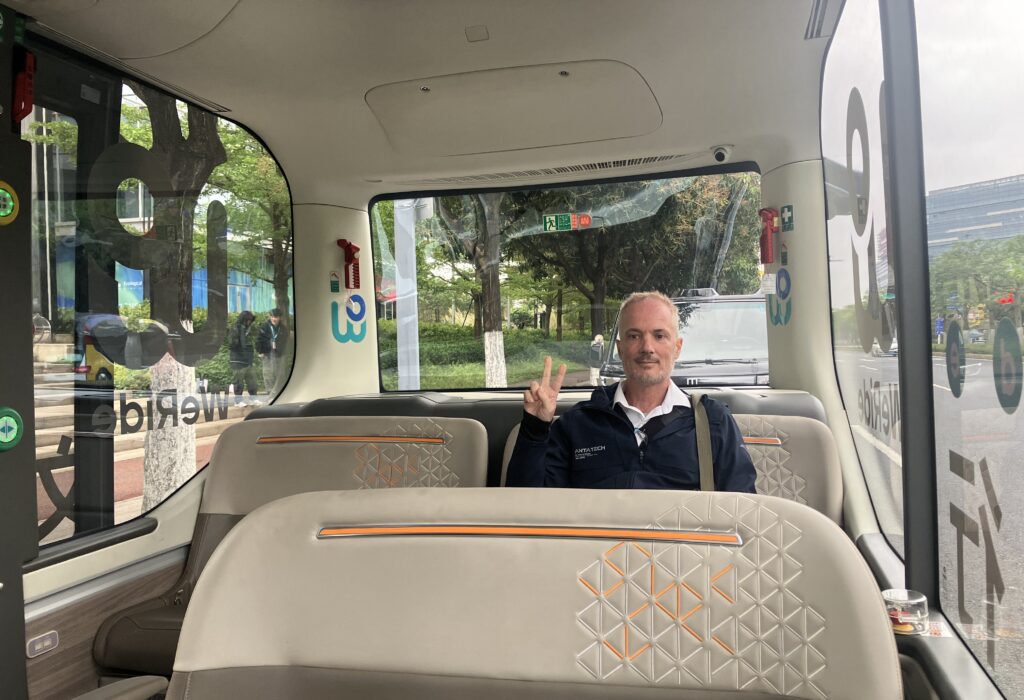
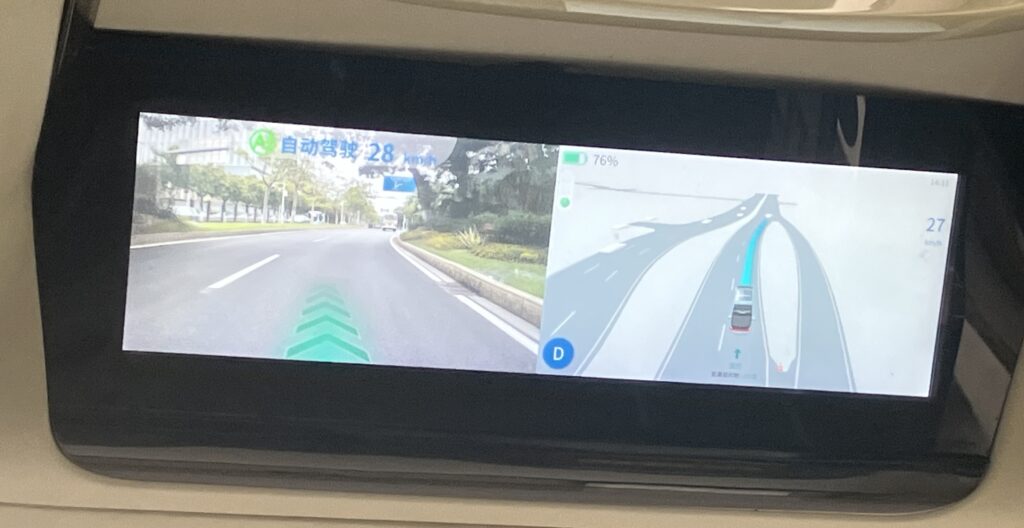
So that’s my first take-away. The WeRide Robobus is really cool. But it needs a cooler name.
We also took a ride in a robotaxi. It was their new GXR, the latest model for their robotaxi. It was made with Geely Farizon and can go up to 120 km/hr.
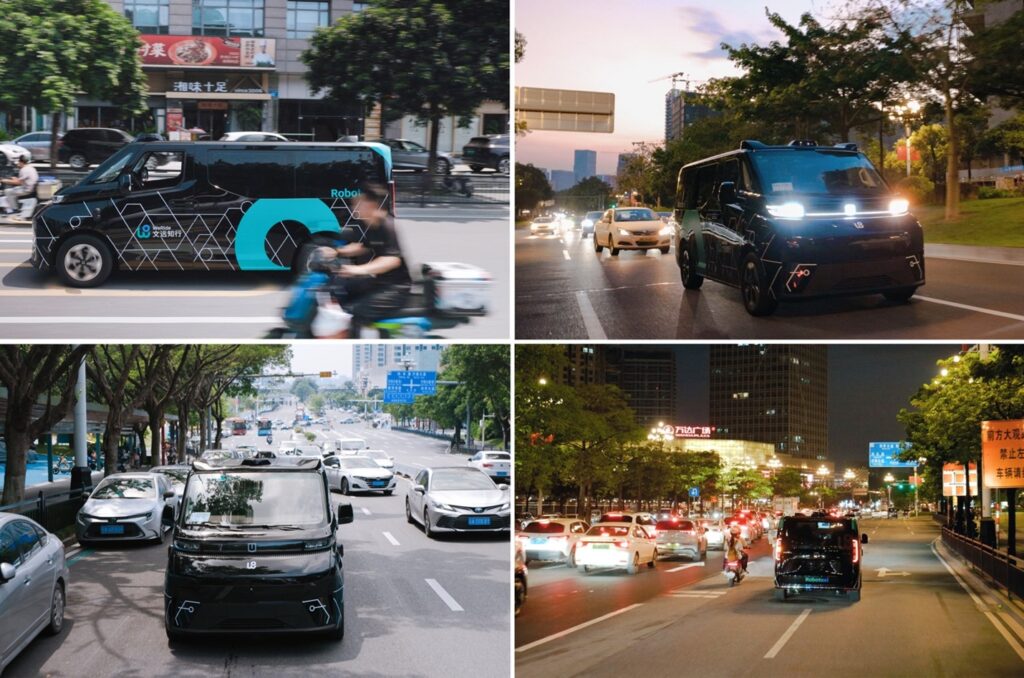
Here’s the roof, where you can see the LiDAR. It also has high-definition cameras.


Here’s a standard photo of an earlier model.

We also saw the robovans. Which have similar sensors on top. You can see the side panel which opens and has all the packages inside.
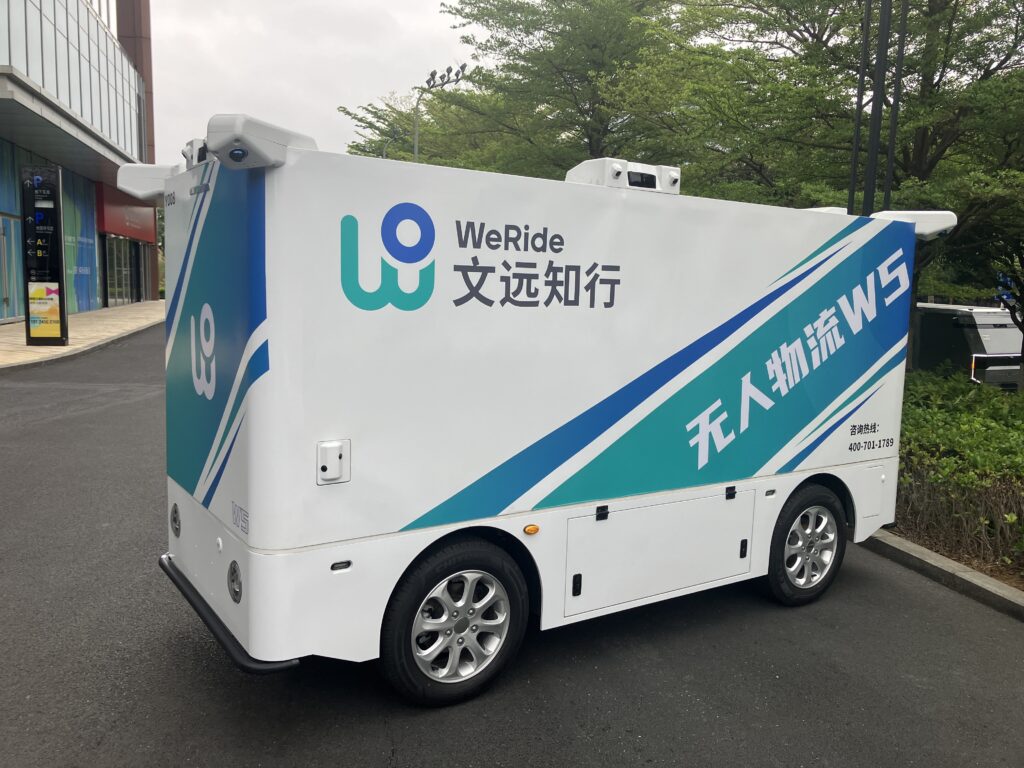

Finally, there are the street sweepers. Which come in two sizes.
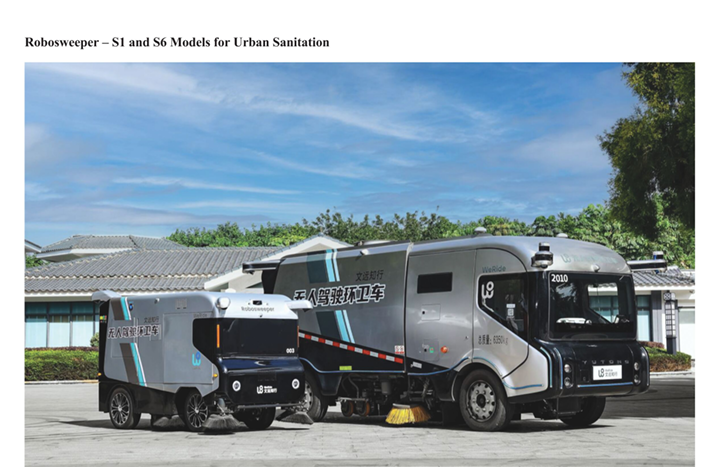
Take-Away 2: WeRide Is Making Rapid Progress in the UAE
WeRide is going for lots of countries, cities, vehicle types, and use cases.
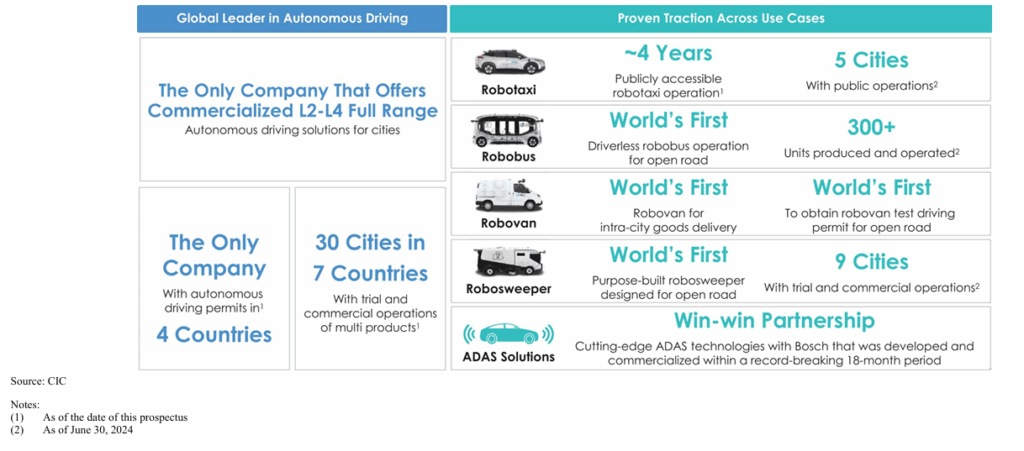
They are arguably the furthest ahead in the UAE.
- In July 2023, WeRide became the first company to receive the UAE’s first national license for self-driving vehicles, permitting testing and operation on public roads across the country.
- In December 2024, WeRide launched its Robotaxi service on the Uber platform in Abu Dhabi. This marked the first time autonomous vehicles were available on Uber outside the US.
- In April 2025, WeRide partnered with Dubai’s Road and Transport Authority (RTA) and Uber to bring its Robotaxi services to Dubai, integrating them into the city’s transport network via the Uber app.
- On May 6, WeRide and Uber announced an expansion of their strategic partnership to include 15 additional cities over the next five years. In these cities, WeRide’s robotaxi services will be available through the Uber app, and Uber will be responsible for fleet operations. As part of this expanded partnership, Uber has also committed to a US$100 million equity investment in WeRide for the development and deployment of autonomous mobility solutions.
- On May 16, 2025, WeRide announced the launch of fully driverless Robotaxi testing in Abu Dhabi – the first deployment of its kind in the Middle East. Starting this quarter, a fleet of WeRide’s Robotaxis will be piloted on public roads without a safety driver.
WeRide now has permission to operate all their autonomous vehicles in the UAE. And they have deployed their robotaxis as a stand-alone service. They have +50 robotaxis, which are available through the TXAI and the Uber apps.
The government permissions are obviously the biggest part of this. You need certain permits to have autonomous driving with a safety driver in the car. And then another level to have no safety driver. And this is often city by city. And vehicle type by vehicle type. The UAE has made this more straightforward than most places. It also helps that there aren’t really taxi unions in the UAE. And there is a large expat community that can pay for a more luxury service.
WeRide is also expanding to Saudi Arabia, which means different political dynamics, regulation and consumer base. In late 2022, WeRide partnered with the Saudi Company for Artificial Intelligence (SCAI), which is owned by the Saudi Public Investment Fund (PIF), to launch the first demonstration route of its driverless Mini Robobus.
Take-Away 3: Partnerships Play a Crucial Role in WeRide’s Strategy
After regulatory approvals, commercial advancement is the other big question for going to market. And really that is about partnerships.
Leap frogging directly to L4 AD vehicles means working with OEMs. WeRide doesn’t do hardware in house. So that means partners like Renault, GAC, Chery, Geely, YuTong Bus, and others.
For example:
- In 2019, WeRide formed a joint venture with GAC Group, launching their initial L4 Robotaxi fleet based on GAC vehicles.
- WeRide partnered with bus manufacturer YuTong to jointly develop and mass-produce the WeRide Mini Robobus. This vehicle is notable for being purpose-built for autonomous driving and lacking a traditional cockpit (steering wheel, pedals).
- The new GXR Robotaxi was jointly developed by WeRide and Farizon New Energy Commercial Vehicle Group, the commercial vehicle sector of Geely Holding. This vehicle was specifically designed for mass production and scalable L4 autonomous operation.
In addition, WeRide has technology partners. Such as Bosch, Nvidia, Tencent Cloud, etc.
Finally, they need data, regulatory and operating partnerships. This is done region by region. Think about what it takes to operate AD in a city. You need:
- Government regulation and permissions.
- Insurance (not easy).
- Cloud service.
- Data privacy and controls. Usually, data must be kept locally. This is particularly strict in the EU.
- Operating partnerships – such as for taxi services (including Uber), street cleaning, logistics partners and local bus / transportation services (usually government).
WeRide’s approach is to offer the tech and vehicles. And the local partner takes care of the cloud, data, operations, and government activities. For example:
- WeRide is collaborating with OEM Renault Group and local operator Beti Automated Mobility (along with insurer Macif) to provide a driverless commercial Robobus service in Drôme, France. They started operations in early 2025.
- WeRide was chosen as the technology provider for a Robotaxi pilot project in Zurich, Switzerland. This project involves collaboration with the Swiss Transit Lab (STL), funding from the Canton of Zurich, and involvement from the Swiss national railway (SBB).
***
Those are my take-aways. It’s an interesting company at an interesting stage of development.
Cheers, Jeff
———
Related articles:
- BYD Is Going for Global EV Leadership (1 of 2) (Tech Strategy – Daily Article)
- 3 Factors Will Determine the Future of Verisign Inc. (Tech Strategy – Podcast 191)
- A Strategy Breakdown of Arm Holdings (1 of 3) (Tech Strategy – Daily Article)
From the Concept Library, concepts for this article are:
- Autonomous Vehicles
From the Company Library, companies for this article are:
- WeRide
———
I am a consultant and keynote speaker on how to accelerate growth with improving customer experiences (CX) and digital moats.
I am a partner at TechMoat Consulting, a consulting firm specialized in how to increase growth with improved customer experiences (CX), personalization and other types of customer value. Get in touch here.
I am also author of the Moats and Marathons book series, a framework for building and measuring competitive advantages in digital businesses.
This content (articles, podcasts, website info) is not investment, legal or tax advice. The information and opinions from me and any guests may be incorrect. The numbers and information may be wrong. The views expressed may no longer be relevant or accurate. This is not investment advice. Investing is risky. Do your own research.
